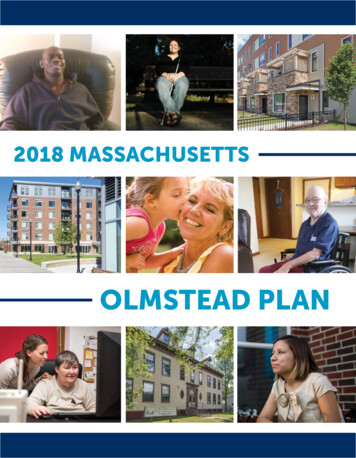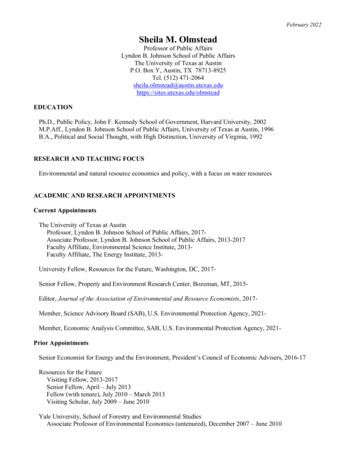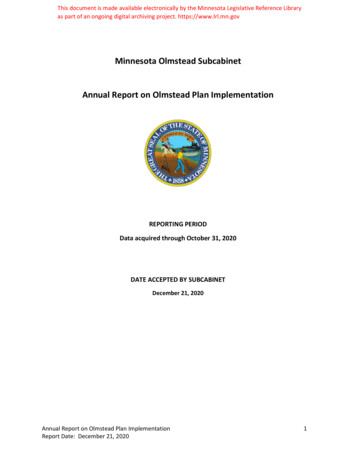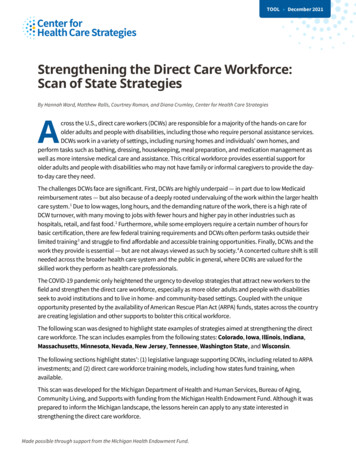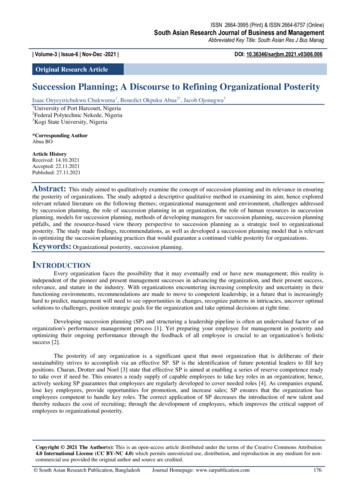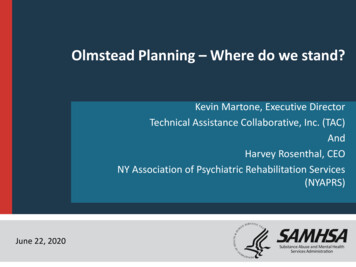
Transcription
Olmstead Planning – Where do we stand?Kevin Martone, Executive DirectorTechnical Assistance Collaborative, Inc. (TAC)AndHarvey Rosenthal, CEONY Association of Psychiatric Rehabilitation Services(NYAPRS)June 22, 2020
Disclaimer This webinar was developed [in part] undercontract numberHHSS283201200021I/HHS28342003T from theSubstance Abuse and Mental Health ServicesAdministration (SAMHSA), U.S. Department ofHealth and Human Services (HHS). The views,policies and opinions expressed are those ofthe authors and do not necessarily reflectthose of SAMHSA or HHS.2
Kevin Martone, Executive DirectorThe Technical Assistance Collaborative (TAC)Olmstead Planning and Implementation3
Topics to be Discussed What is Olmstead? What does community integration mean? What did the U.S. Supreme Court say regardingOlmstead Plans? What should an effective Olmstead Plan include? How have states approached Olmstead planning? What are examples of activities in OlmsteadPlans? What are some lessons learned in working withstates on Olmstead planning?4
The Mandate for Community Integration In the landmark Olmstead v. L.C. decision (1999), the U.S.Supreme Court held that states have an affirmative obligationto ensure that individuals with disabilities live in the mostintegrated settings possible. The regulations implementing Title II of the Americans withDisabilities Act (ADA) define an integrated setting as one that“enables individuals with disabilities to interact withnondisabled persons to the fullest extent possible.” 28 C.F.R. § 35.130(d) 28 C.F.R. § Pt. 35, App. A (2010) (addressing § 35.130)5
Community Integration Defined“Integrated settings are located in mainstream society; offeraccess to community activities and opportunities at times,frequencies and with persons of an individual’s choosing; affordindividuals choice in their daily life activities; and, provideindividuals with disabilities the opportunity to interact with nondisabled persons to the fullest extent possible. Evidence-basedpractices that provide scattered-site housing with supportiveservices are examples of integrated settings.”U.S. Department of Justice. Statement of the Department of Justice on Enforcement of theIntegration Mandate of Title II of the Americans with Disabilities Act and Olmstead v. L.C.6
Community Integration Defined“By contrast, segregated settings often have qualities of aninstitutional nature. Segregated settings include, but arenot limited to: (1) congregate settings populated exclusivelyor primarily with individuals with disabilities; (2) congregatesettings characterized by regimentation in daily activities,lack of privacy or autonomy, policies limiting visitors, orlimits on individuals’ ability to engage freely in communityactivities and to manage their own activities of daily living;or (3) settings that provide for daytime activities primarilywith other individuals with disabilities.”U.S. Department of Justice. Statement of the Department of Justice on Enforcement of theIntegration Mandate of Title II of the Americans with Disabilities Act and Olmstead v. L.C.7
What is an Olmstead Plan? In its decision, the Supreme Court stated that if a state hada, “ .comprehensive, effectively working plan for placingqualified persons with mental disabilities in less restrictivesettings, and a waiting list that moved at a reasonable pacenot controlled by the state’s endeavors to keep itsinstitutions fully populated, the reasonable modificationstandard [of the ADA] would be met.” For an Olmstead Plan to serve as a reasonable defenseagainst legal action it must include, “ concrete and reliablecommitments to expand integrated opportunities .andthere must be funding to support the plan.”U.S. Department of Justice. Statement of the Department of Justice on Enforcement of theIntegration Mandate of Title II of the Americans with Disabilities Act and Olmstead v. L.C.8
Olmstead Plan should generally include: A description of the state’s current system of providingcommunity-based services and supports to people withdisabilities; An assessment of the strengths and weaknesses of thatsystem; and A description of the state’s plan and goals for expandingopportunities for providing community-based services andsupports to people with disabilities.9
Settings often addressed in Olmstead PlansInstitutional or segregated in nature- State hospitals and Developmental Centers- Nursing Facilities- Board and Care (e.g. Adult Homes, Assisted Living, Residential Care)- Congregate living programs- Incarceration- Sheltered employment workshops or day programsAt-Risk of Institutionalization- Homelessness- At home with aging parents- Other substandard living conditions10
Examples of Key Olmstead Plan Ingredients 11Populations to be addressedData analysisHousingEmploymentWellness and integrated healthcareTransportationSupports and servicesFundingPolicies, rules and regulationsOutcomesTraining and workforce development, including use ofpeer workforce
Examples of Data Analysis* Populations served (e.g. by disability, age, race/ethnicity) Where funding is allocated (i.e. segregated vs integrated settings) Where people are served (e.g. hospitals, emergency departments,jails, day programs, employment) Where people live (e.g. hospitals, adult homes, homelessness,supportive housing) Capacity of services and housing against need Reimbursement issues Workforce shortages*This is a non-exhaustive list of examples. There are other types of data thatmay be considered in Olmstead planning.12
Cycle of Olmstead PlanningSystem Implementation13Olmstead PlanDevelopment andModification
State Approaches to Olmstead Planning Doing nothing Planning with little action Proactive planning Reactive planning Litigation/Settlement Agreements14
Examples of Stakeholder Input Olmstead Advisory Council or sub-committees Existing Statewide and Regional Stakeholder Meetings Listening Sessions On-line Input and Feedback Legislative involvement15
State Experiences and Implementation Issues Successful Olmstead planning requires committed leadership,including from the Governor’s office, Budget offices and otherState agencies, legislature Planning and implementation usually require cross agencyinvolvement It can be a challenge to get other state agencies to the table The legislature must be educated about Olmstead and awareof the planning process Community Integration/Olmstead takes resources, newand/or re-allocated16
State Experiences and Implementation Issues Need to prepare internal staff; not all staff are on board Developing an inclusive planning process with stakeholderscan be hard Anticipate and manage resistance Talking about Olmstead is not a good defense, nor is a planthat sits on a shelf17
Cautions Just because it’s in the community doesn’t mean it’sintegrated “Choice” may have different meanings to different people A plan to plan is not a plan Budget cuts and bureaucracy do not trump civil rights18
Takeaways An Olmstead Plan is a system change document. You are defenseless without an Olmstead Plan. Be comprehensive, but realistic. A plan should beactionable and achievable. Plans must focus on expanding access to integratedsettings, not segregated settings.19
Takeaways Better to have a short, actionable plan than a ZZZ pagedocument that just identifies the issues and barriers towhy progress can’t be made. The Plan should be developed with stakeholderinvolvement. Have short and long term goals. Track and report on progress.20
Harvey Rosenthal, CEONew York Association of Psychiatric Rehabilitation Services (NYAPRS)New York Olmstead Planning andImplementation21
New York’s Olmstead related Policies New York’s Most Integrated SettingCoordinating Council (MISCC) was establishedin 2002 following strong advocacy fromphysical and psychiatric disability groups Comprised of state agency representativesand 9 public members Intended to meet quarterly and promotedincreased access to increased housing,employment and transportation22
Statutorily Defined MISSC Members: State Agencies Office of People with Developmental DisabilitiesNew York State Office of Mental HealthDepartment of Health,Office for the AgingEducation Department– Adult Continuing Education Services – Vocational Rehabilitation Office of Alcohol and Substance Abuse ServicesDivision of Housing and Community RenewalDepartment of TransportationOffice of Children and Family Services– Commission for the Blind Office of Temporary and Disability Assistance Justice Center for the Protection of People with Special Needs23
Statutorily Defined MISSC Members: Public Members9 Appointed Public Members 3 consumers of services for individuals withdisabilities 3 individuals with expertise in the field ofcommunity services for people of all ages withdisabilities 3 individuals with expertise in or recipients ofservices available to senior citizens withdisabilities24
MISCC 2002-2011 Formed committees relative to housing,employment, transportation 2002-2011 began as quarterly meetings anddevolved thereafter 1 report Little impact25
Employment Activities unrelated to the MISCC ‘New York Works’: Federal DOL pilot allowingpeople to keep their SSI and Section 8payments; promising initial results;discontinued by DOL Medicaid Buy In program created in 2003following strong advocacy by mental health,AIDS/HIV and physical disability advocates Medicaid Infrastructure Grant created NewYork Makes Work Pay in 201126
New York Makes Work Pay 2009-2011 Encourage commitment to employment and collaborationamong state agencies Educate and encourage providers to increase competitiveemployment outcomes for people with disabilities Work with employers to increase hiring levels Implement a process to move from sheltered/segregated tocompetitive/integrated employment Encourage entrepreneurship Increase access to work incentives planning, health care, &asset accumulation tools and strategies Work with schools to increase competitive employmentoutcomes for youth with disabilities27
Cuomo Administration 2011 Formed Olmstead cabinet that released anOlmstead Implementation Plan 2012 Adult Home settlement in 2013 Created the Justice Center for the Protection ofPeople with Special Needs in 2013 from 1977Commission on Quality of Care and Advocacy andother agency personnel Employment First Executive Order 2014 Chief Disability Officer to be appointed in 202028
2013 Recommendations of the Olmstead Cabinet Provide access to housing Provide employment services to afford opportunitiesfor work that is not degrading Provide access to transportation services that are notdependent on Medicaid Coordinate children’s services so as to provide for asmooth transition from childhood into adulthood Work with aging services to avoid needless nursinghome placements Work with the criminal justice system to promotediversion and appropriate treatment for those who endup in that system29
2014 Employment First Executive Order: Goals Increase the employment rate of individualswith disabilities by 5%. Decrease the poverty rate of individuals withdisabilities by 5%. Register 100 businesses as having formalpolicies to hire people with disabilities as partof their workforce strategy.30
Some Employment First Strategies Create an Employment First Service Culture Maximize federal funding through Ticket toWork program Medicaid Buy-In Enrollment– Streamline and standardize enrollment process– Promote state takeover of Medicaidadministration from local districts to centralizeand create consistency in determinations Expand ACCES-VR self-employment initiatives31
Adult Home Settlement Implementation Adult Home settlement in 2013 Very slow movement of residents into thecommunity due to operator resistance andflawed implementation and complex healthhome processes Adult Home Plus Program 1:12 ratio 5 million to create 2 Adult Home Peer Bridgerinitiatives32
Medicaid Redesign Team 1 2012-13 Care Management for All Behavioral Health:– Integration of BH, Medical and Pharmacybenefits into ‘Health and Recovery Plans’– Health Home Coordination– Access to Home and Community BasedServices MRT Affordable and Supportive Housing 2.2 billion in Medicaid reduction33
Medicaid Redesign Team 2 Cut Medicaid spending by 2.5 billion– Restricting access to Consumer Directed PersonalAssistance Program– Reduce Medicaid transportation spending: transitionto a Medicaid Transportation Broker program– Discontinue Future Social Determinants of HealthInvestments– Eliminate Health Home Outreach funding– Lower Health Home caseload size– Increase children’s behavioral health programming34
Criminal Justice 2019 Increased diversion and re-entry programs Crisis Intervention Teams: 5 million fromlegislature over last 5 years Some willingness in NYC to make EMTs andmental health counselors and peers to be firstresponders Very limited reduction in use of solitaryconfinement; resistance to reducing its use andapproving HALT reform legislation; enacting avery limited ban for people with disabilities35
Some Lessons from NY Relentless advocacy required to press for meaningfulimplementation across successive Administrations Many advances are not connected with and happenedoutside of the Olmstead body and planning process. Measurable outcomes a must, both re MISCC andMedicaid Value Based Payment policies Unique focus on employment Even legal actions produce limited results Criminal justice reforms are essential Promising focus on social determinants of health Money is a primary factor, e.g. Medicaid investments,cuts and commitment36
SAMHSA’s mission is to reduce the impact of substanceabuse and mental illness on America’s communities.Kevin Martone, TACkmartone@tacinc.orgHarvey Rosenthal, -7 (1-877-726-4727) 1-800-487-4889 (TDD)37
For an Olmstead Plan to serve as a reasonable defense against legal action it must include, concrete and reliable commitments to expand integrated opportunities .and there must be funding to support the plan. 8 What is an Olmstead Plan? U.S. Department of Justice. Statement of the Department of Justice on Enforcement of the
